Amplitude Distribution of Partial Discharge Signals on Tunnel-Installed High-Voltage Cables
Abstract
:1. Introduction
2. Cable Model
2.1. Distributed Parameters of Tunnel-Installed Cables
2.2. Cable Characteristic Admittance Model
3. Amplitude Distribution Characteristics of Signals on Cross-bonding Wires
3.1. Current Reflection at Cross-Bonding Links
3.2. Amplitude Distribution of PD Signal
- (1)
- The current signals on the two cross-bonding wires connected to the defective phase are equal and denoted as Imajor. In the case of A-B, B-C, and C-A, as shown in Figure 1, if PD occurs in phase A, the signals on wire A and wire C are the same.
- (2)
- The current signal on the remaining cross-bonding wire is denoted as Iminor. The current Iminor has the same polarity with Imajor, but the amplitude is smaller. The proportional relationship between the two currents is determined by the characteristic admittance ratio α:
3.3. Influence of Cable Laying Parameters on Amplitude Distribution
4. Experimental Verification
5. On-Site Measurements
6. Conclusions
Author Contributions
Funding
Conflicts of Interest
References
- Mahdipour, M.; Akbari, A.; Werle, P. Charge concept in partial discharge in power cables. IEEE Trans. Dielectr. Electr. Insul. 2017, 24, 817–825. [Google Scholar] [CrossRef]
- Chen, X.; Qian, Y.; Xu, Y.; Sheng, G.; Jiang, X. Energy estimation of partial discharge pulse signals based on noise parameters. IEEE Access 2016, 4, 10270–10279. [Google Scholar] [CrossRef]
- Mor, A.R.; Morshuis, P.H.F.; Smit, J.J. Comparison of charge estimation methods in partial discharge cable measurements. IEEE Trans. Dielectr. Electr. Insul. 2015, 22, 657–664. [Google Scholar] [CrossRef]
- Ahmed, N.H.; Srinivas, N.N. On-line partial discharge detection in cables. IEEE Trans. Dielectr. Electr. Insul. 1998, 5, 181–188. [Google Scholar] [CrossRef]
- Wild, M.; Tenbohlen, S.; Gulski, E.; Jongen, R. Basic aspects of partial discharge on-site testing of long length transmission power cables. IEEE Trans. Dielectr. Electr. Insul. 2017, 24, 1077–1087. [Google Scholar] [CrossRef]
- Eigner, A.; Rethmeier, K. An overview on the current status of partial discharge measurements on AC high voltage cable accessories. IEEE Electr. Insul. Mag. 2016, 32, 48–55. [Google Scholar] [CrossRef]
- Li, C.; Ma, G.; Qi, B.; Zhang, G.; Su, Q. Condition monitoring and diagnosis of high-voltage equipment in China-recent progress. IEEE Electr. Insul. Mag. 2013, 29, 71–78. [Google Scholar] [CrossRef]
- Wu, M.; Cao, H.; Cao, J.; Hai-Long, N.; Gomes, J.B.; Krishnaswamy, S.P. An overview of state-of-the-art partial discharge analysis techniques for condition monitoring. IEEE Electr. Insul. Mag. 2015, 31, 22–35. [Google Scholar] [CrossRef]
- Weissenberg, W.; Farid, F.; Plath, R. On-site PD detection at cross-bonding links of HV cables. In CIGRE Session; CIGRE: Paris, France, 2004. [Google Scholar]
- Xu, Y.; Gu, X.; Liu, B.; Hui, B.; Ren, Z.; Meng, S. Special requirements of high frequency current transformers in the on-line detection of partial discharges in power cables. IEEE Electr. Insul. Mag. 2016, 32, 8–19. [Google Scholar] [CrossRef]
- Babaee, A.; Shahrtash, S.M. On-line partial discharge defected phase selection and localization in cross-bonded single core cables. IEEE Trans. Dielectr. Electr. Insul. 2015, 22, 2995–3006. [Google Scholar] [CrossRef]
- Sheng, B.; Zhou, W.; Yu, J.; Meng, S.; Zhou, C.; Hepburn, D. On-line PD detection and localization in cross-bonded HV cable systems. IEEE Trans. Dielectr. Electr. Insul. 2014, 21, 2217–2224. [Google Scholar] [CrossRef]
- Wang, Z.; Liu, C.; Wang, Z.; Gao, C.; Sui, H. Application of capacitor sensor in PD detection at the three-phase cross-bonding link-system of XLPE Cable. In Proceedings of the 2010 Annual Report Conference on Electrical Insulation and Dielectric Phenomena (CEIDP), West Lafayette, IN, USA, 17–20 October 2010; pp. 1–3. [Google Scholar]
- Ametani, A. A general formulation of impedance and admittance of cables. IEEE Trans. Power Appar. Syst. 1980, PAS-99, 902–910. [Google Scholar] [CrossRef]
- Dommel, H.W. Underground cables. In EMTP Theory Book; Microtran Power System Analysis Corporation: Portland, OR, USA, 1992; pp. 150–192. [Google Scholar]
- Pollaczek, F. Uber das Feld einer unendlich langen wechselstromdurchflossen Einfachleitung. Elektr. Nachr. Tech. 1926, 3, 339–360. [Google Scholar]
- Tylavsky, D.J. Conductor impedance approximations for deep-underground mines. IEEE Trans. Ind. Appl. 1987, 4, 723–730. [Google Scholar] [CrossRef]
- Wu, M. Physical interpretation of impedance formulas for conductors enclosed in a cylindrical tunnel. IEEE Trans. Power Deliv. 2011, 26, 1354–1360. [Google Scholar]
- Chen, Y.; Gong, Q.; Chen, Y.; Cao, Y. Study of traveling wave at the sheath—Crossing point of high voltage power cable. High Volt. Eng. 2008, 32, 799–803. [Google Scholar]
- Wu, W.; Zhang, F. Power System Over-Voltage Numerical Calculation; Science Press: Beijing, China, 1989; pp. 155–174. [Google Scholar]
- Paul, C.R. Frequency-Domain analysis of multiconductor lines. In Analysis of Multiconductor Transmission Lines; John Wiley & Sons: Hoboken, NJ, USA, 2008; pp. 282–342. [Google Scholar]
- Lemke, E. Analysis of the partial discharge charge transfer in extruded power cables. IEEE Electr. Insul. Mag. 2013, 29, 24–28. [Google Scholar] [CrossRef]
- Ametani, A. Wave propagation characteristics of cables. IEEE Trans. Power Appar. Syst. 1980, PAS-99, 499–505. [Google Scholar] [CrossRef]
- Zhang, C.G.; Yao, L.; Qian, Y.; Huang, C.; Jiang, X. Application of HF/UHF joint partial discharge analysis to on-site power cable terminal detection. Electr. Power Autom. Equip. 2010, 30, 92–95. [Google Scholar]
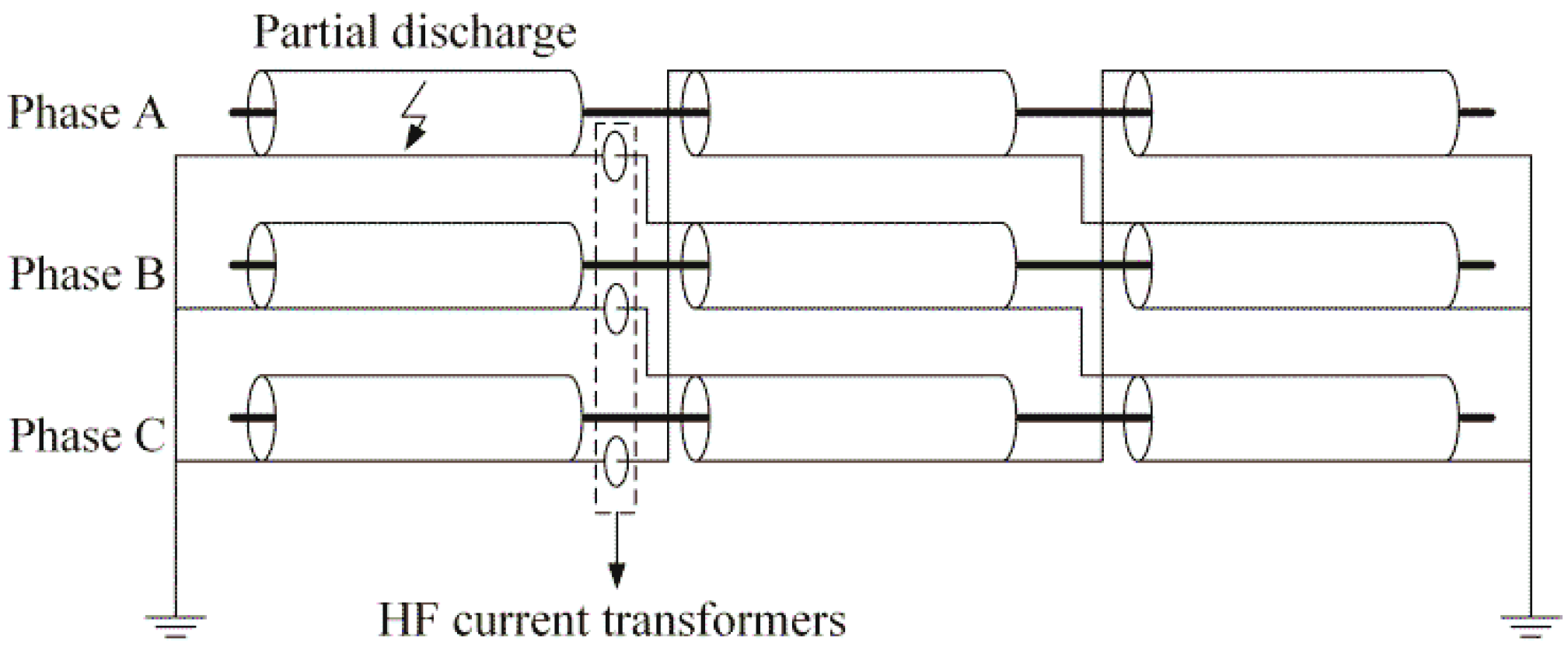

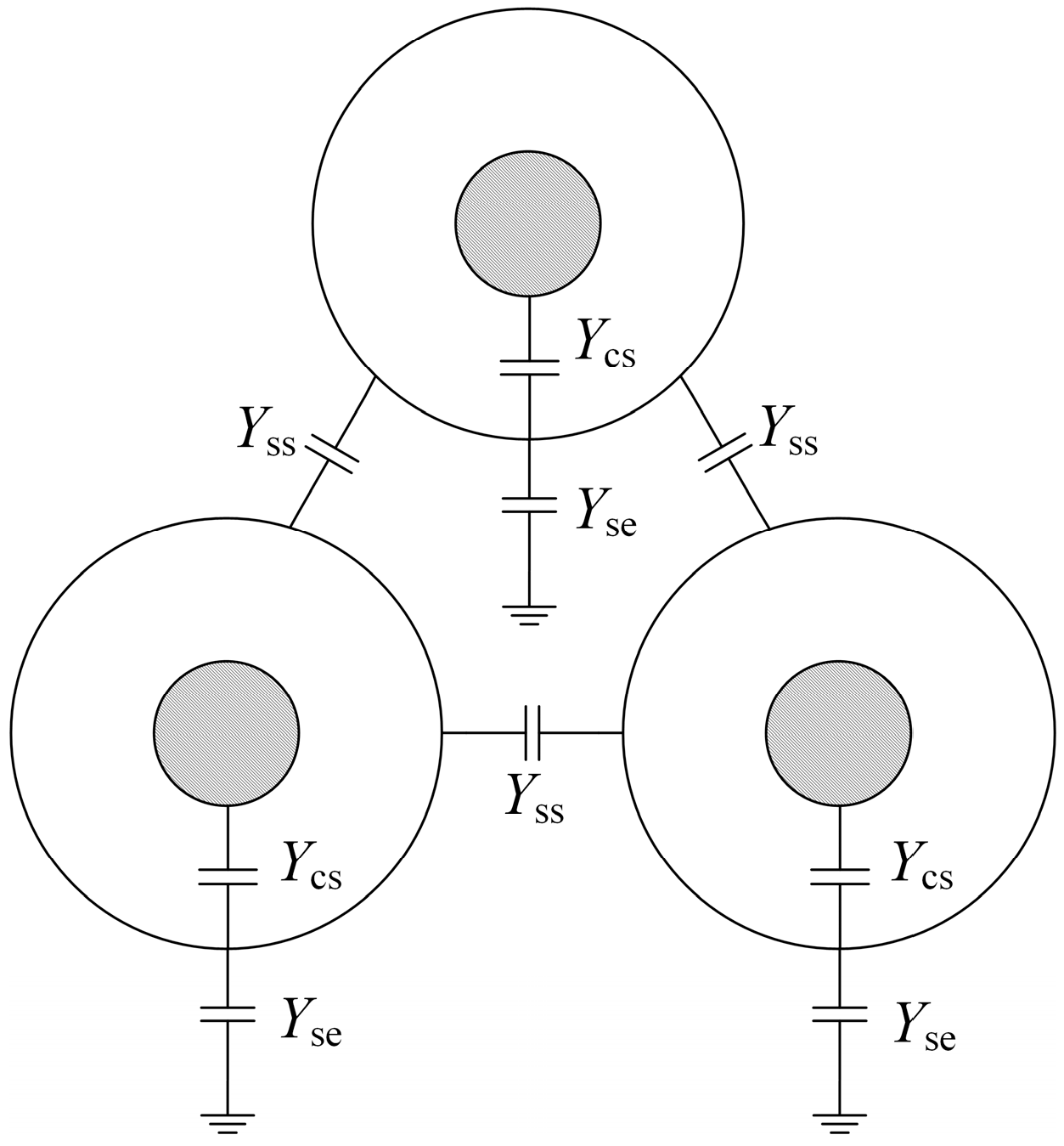


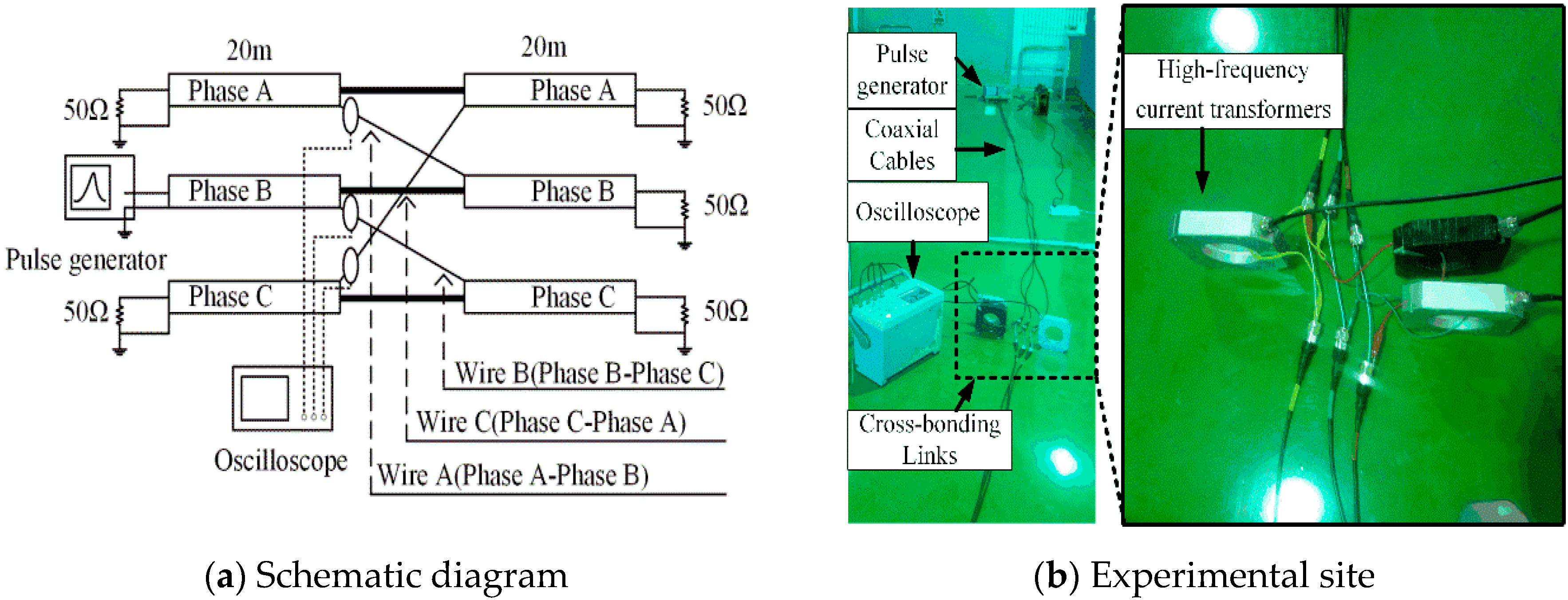
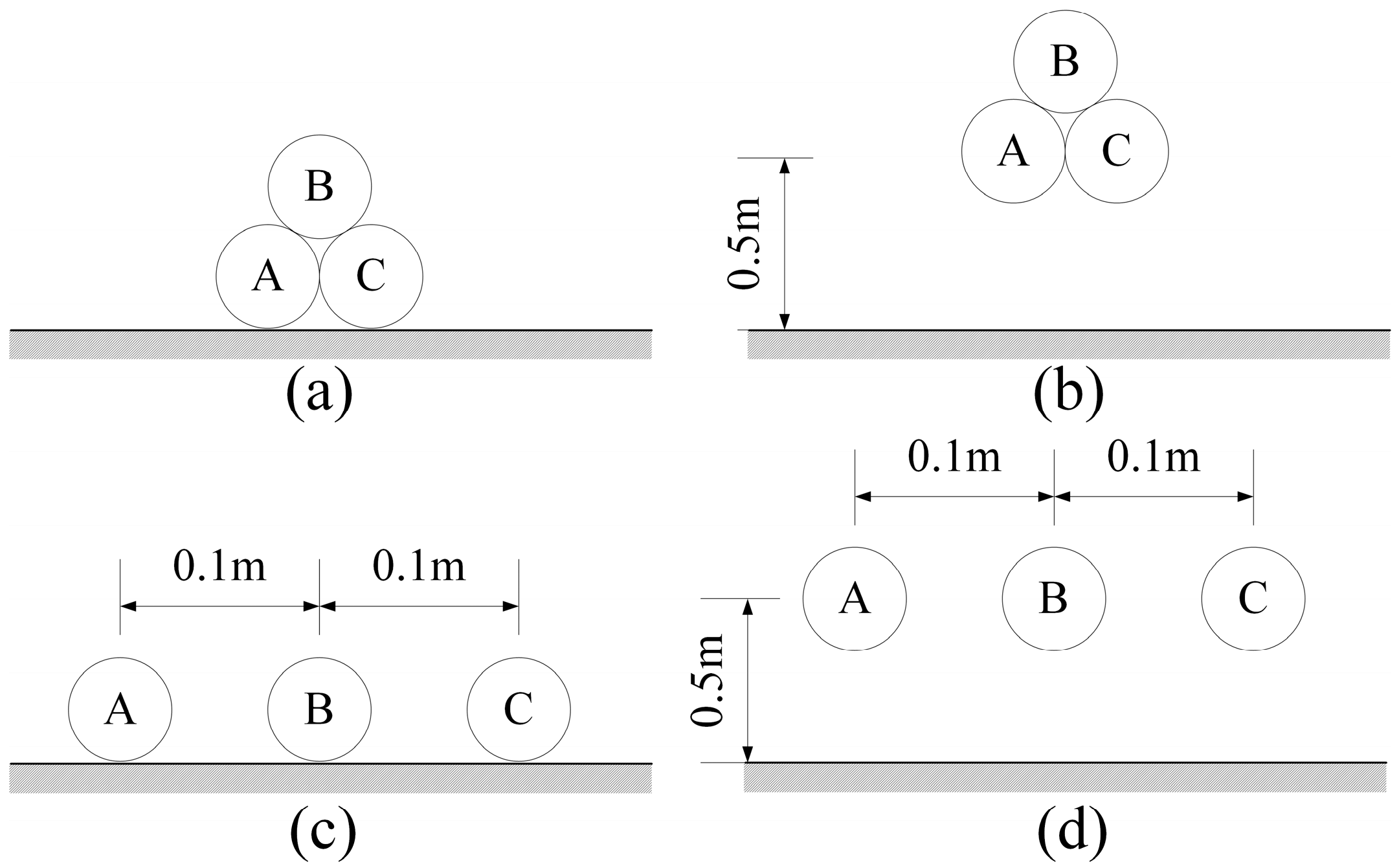
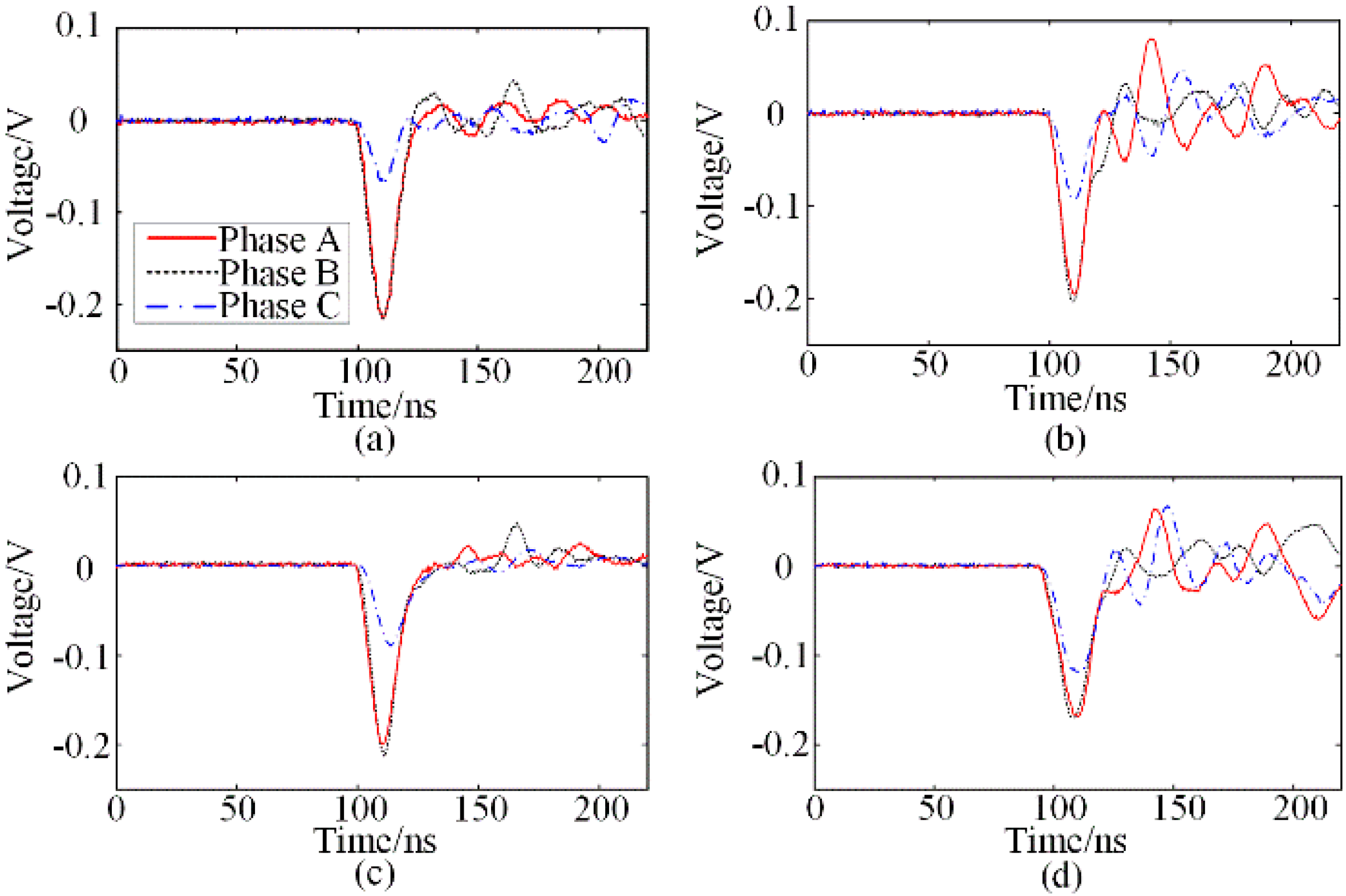
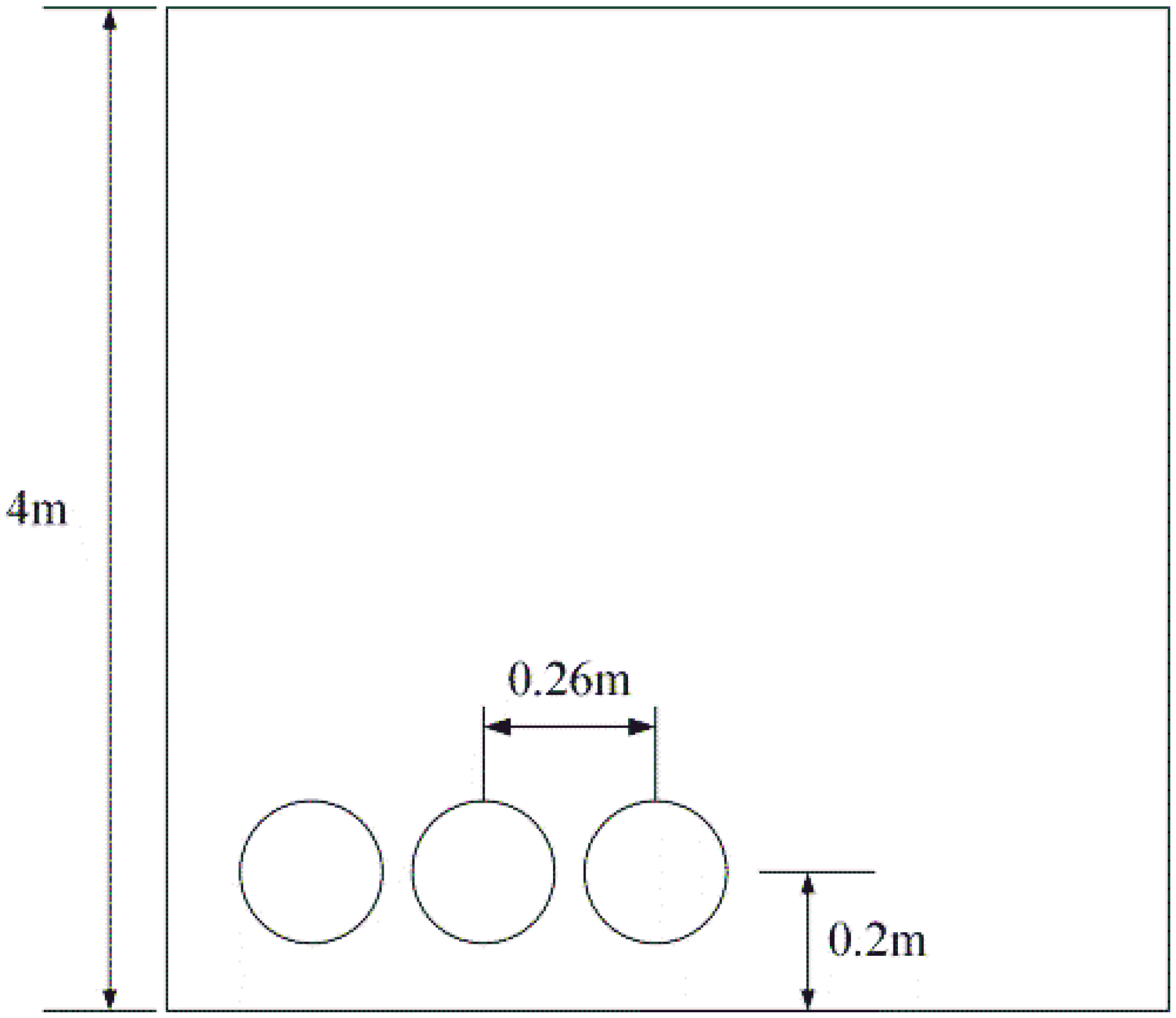
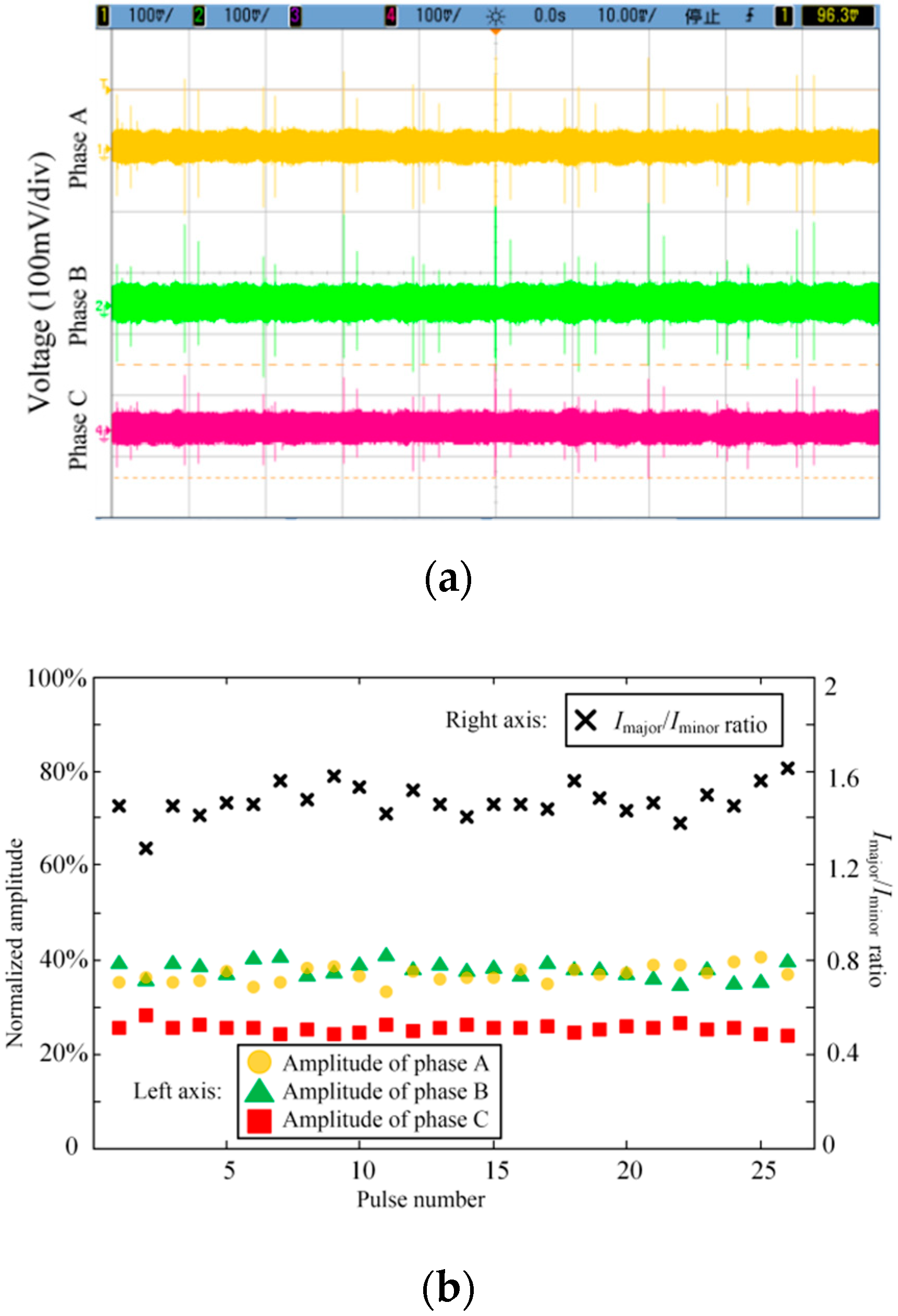
| Laying Parameters | |||
|---|---|---|---|
| Tunnel radius R/m | 2 | Earth resistivity ρ/(Ω∙m) | 100 |
| Cable center spacing d/m | 0.2 | Cable distance from the tunnel wall R-b/m | 0.5 |
| Cable parameters (YJLW03 127/220 1 × 1000) | |||
| Inner conductor radius r1/mm | 19 | Relative dielectric constant of insulation ε1 | 2.3 |
| Insulation radius r2/mm | 46 | Relative dielectric constant of sheath ε2 | 3 |
| Sheath radius r3/mm | 48.4 | Inner conductor resistivity ρ1/(Ω∙m) | 1.7 × 10−8 |
| Cable radius r/mm | 53.4 | Sheath resistivity ρ2/(Ω∙m) | 2.1 × 10−8 |
| Inner Conductor Radius r1/mm | 0.45 | Insulating Layer Relative Dielectric Constant ε1 | 2.3 |
| Insulation radius r2/mm | 1.475 | Sheath relative dielectric constant ε2 | 3 |
| Metal shielding radius r3/mm | 2.1 | Inner conductor resistivity ρ1/(Ω∙m) | 1.75 × 10−8 |
| Cable radius r/mm | 2.675 | Metal shielding resistivity ρ2/(Ω∙m) | 1.75 × 10−8 |
| Laying Configuration | Peak-to-Peak Value | Average Amplitude Spectrum | Imajor/Iminor | ||||||
|---|---|---|---|---|---|---|---|---|---|
| Phase A | Phase B | Phase C | Phase A | Phase B | Phase C | Peak-to-Peak Value | Average Amplitude Spectrum | Theoretical Value | |
| Mode a | 0.239 | 0.259 | 0.094 | 0.137 | 0.138 | 0.034 | 2.65 | 4.04 | 4.42 |
| Mode b | 0.269 | 0.236 | 0.138 | 0.119 | 0.124 | 0.051 | 0.183 | 2.38 | 2.64 |
| Mode c | 0.227 | 0.263 | 0.109 | 0.123 | 0.124 | 0.049 | 2.25 | 2.52 | 2.59 |
| Mode d | 0.233 | 0.216 | 0.187 | 0.119 | 0.119 | 0.083 | 1.20 | 1.43 | 1.41 |
© 2019 by the authors. Licensee MDPI, Basel, Switzerland. This article is an open access article distributed under the terms and conditions of the Creative Commons Attribution (CC BY) license (http://creativecommons.org/licenses/by/4.0/).
Share and Cite
Qian, Y.; Chen, X.; Zang, Y.; Wang, H.; Sheng, G.; Jiang, X. Amplitude Distribution of Partial Discharge Signals on Tunnel-Installed High-Voltage Cables. Appl. Sci. 2019, 9, 4595. https://doi.org/10.3390/app9214595
Qian Y, Chen X, Zang Y, Wang H, Sheng G, Jiang X. Amplitude Distribution of Partial Discharge Signals on Tunnel-Installed High-Voltage Cables. Applied Sciences. 2019; 9(21):4595. https://doi.org/10.3390/app9214595
Chicago/Turabian StyleQian, Yong, Xiaoxin Chen, Yiming Zang, Hui Wang, Gehao Sheng, and Xiuchen Jiang. 2019. "Amplitude Distribution of Partial Discharge Signals on Tunnel-Installed High-Voltage Cables" Applied Sciences 9, no. 21: 4595. https://doi.org/10.3390/app9214595
APA StyleQian, Y., Chen, X., Zang, Y., Wang, H., Sheng, G., & Jiang, X. (2019). Amplitude Distribution of Partial Discharge Signals on Tunnel-Installed High-Voltage Cables. Applied Sciences, 9(21), 4595. https://doi.org/10.3390/app9214595





